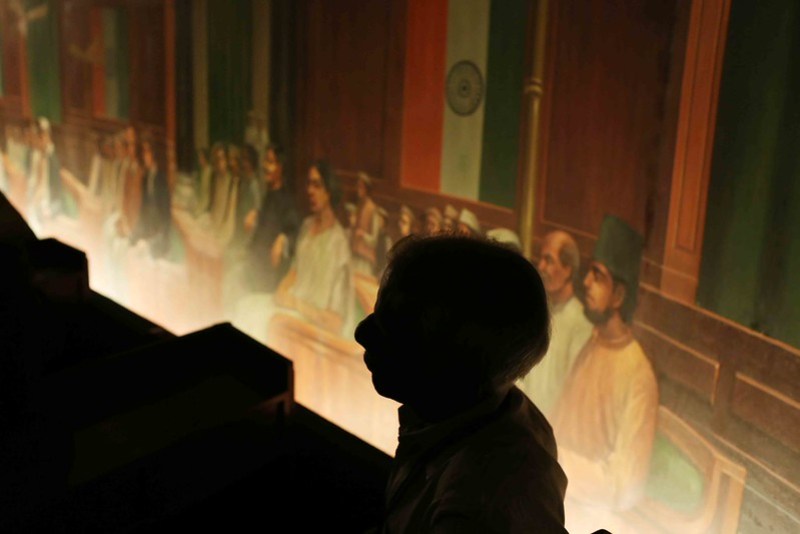
City Monument – Teen Murti House, Central Delhi

Nehru’s last home.
[Text and photos by Mayank Austen Soofi]
A koel perched somewhere on one of the trees is calling out incessantly. A peacock emerges from behind a hedge, but disappears the next instant. The big house exudes an air of aristocratic dignity: There’s a grand marble staircase, throne-like chairs, slatted windows, low-hanging ceiling fans, a stately ballroom with a giant fireplace, framed Buddha images, and dozens of black and white photographs of one man and his family, some of which were taken more than a century ago.
It is like being in a dream. The real world seems far away.
Such are the charms of Teen Murti Bhawan, where Jawaharlal Nehru, India’s first prime minister, lived. Today, home to the Nehru Memorial Museum and Library (NMML), it’s at the centre of controversy, though you don’t sense this when you’re walking through its serene grounds.
In September 2014, The Economic Times quoted NMML chairman Lokesh Chandra as saying that the museum is stuck in the past: “Right now it is only about the times of Nehru… We have to make the museum relevant to today’s times so that questions on governance in present day are addressed…. The idea is to have a variety of exhibits to show our progress and development, from Mangalyaan to smart cities. To attract visitors, especially children, the place has to be made attractive, relevant to contemporary times.”
A day later, NMML director Mahesh Rangarajan issued a statement on the museum’s website, saying: “Teen Murti Bhawan is the house of Nehru the Prime Minister, and the Museum will focus on his years as Prime Minister as he, along with great colleagues, laid the foundations of post-colonial India. It will draw on the rich NMML archives built up over the last fifty years. The collections of the NMML include newspapers on microfilms, photos, audio-videos and archival documents on Modern Indian History. The digitization of the Library collections which is underway will also enhance, improve and enrich the Museum.”
A few days later, Mr Rangarajan resigned, fueling fears that the character of NMML would change irredeemably as the current government tries to rewrite the narrative surrounding the first prime minister. Union culture minister Mahesh Sharma had already questioned Mr Rangarajan’s appointment by the previous government in its dying days.
Built in 1930, Teen Murti Bhawan was designed by Robert Tor Russell, the English architect who also planned Delhi’s premier shopping district of Connaught Place. Originally named Flagstaff House, the 30-acre estate was built for the commander-in-chief of the British Indian army. It got its present name from the three statues installed at the adjacent traffic roundabout that commemorate those killed during World War I in West Asia.
As India’s first prime minister, Nehru initially stayed in a bungalow on York Road (now called Motilal Nehru Marg), allocated to him in September 1946 after he joined the interim government a year before independence. He shifted to Teen Murti Bhawan in mid-1948. A few months after Nehru’s death in 1964, on his 75th birthday actually, it was turned into the Nehru Memorial Museum—the museum was inaugurated by then president Sarvepalli Radhakrishnan.
Since August 2014, parts of Teen Murti Bhawan have been undergoing renovation. Viewers cannot see, for instance, a corridor on the first floor that was lined on both sides with Nehru’s collection of books. They can also no longer view the room in which he died.
If we don’t consider its thali and samosas, the canteen is one of the loveliest spaces in the complex. It has a tree-covered terrace where scholars from the adjacent library often converge for tea. The canteen’s dining hall has large glass windows looking out on to the greens of Teen Murti.
The executive council of the NMML was reconstituted in April 2015. It got a new vice-chairman—a former journalist and a member of the ruling Bharatiya Janata Party, M.J. Akbar, who has also authored the book Nehru: The Making Of India. Mr Akbar has prepared a new plan for the museum which is available on the official website. Among other things, it involves an exhibition room called Cradle to Grave, which will include exhibits from Nehru’s life. Separate spaces have also been planned for permanent exhibitions, with names like Nehru’s Vision of Education, Nehru and Science, Nehru and Cartoons, Nehru and Nature, and Nehru and Culture.
The Teen Murti remains Nehru’s tomb, for now.
Deleting Nehru
1.
2.
2a.
3.
4.
5.
6.
7.
8.
9.
10.
11.
12.
13.
14.
15.
16.
17.
18.
19.
20.
21.
22.
23.
24.
25.
26.
27.





























Those chairs looks great. I love antique furniture.
The chairs have 2 danglers each looped at the bottom of each arm rest, probably to ensure that the cushions don’t fall down. I like this idea very much. The fabric of the cushions appears to be khadi silk…
Aren’t there slides, swings, see-saws etc. in the gardens? Considering how much he’s supposed to have loved children, his museum should reflect that somehow.
Mayank,
The year is 2015. So is The Economic Times article, dated September 2015.
Krish, thank you and sorry. I’m leaving my mistake as it is so that your comment makes sense for posterity.